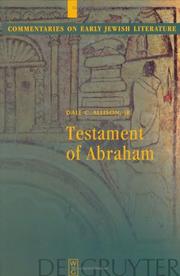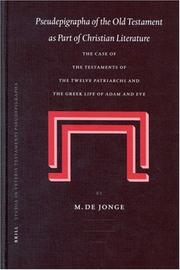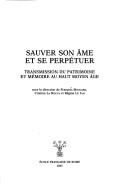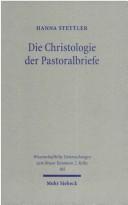| Listing 1 - 10 of 20 | << page >> |
Sort by
|
Book
ISBN: 0773444319 9780773444317 Year: 2013 Publisher: Lewiston The Edwin Mellen Press
Abstract | Keywords | Export | Availability | Bookmark
 Loading...
Loading...Choose an application
- Reference Manager
- EndNote
- RefWorks (Direct export to RefWorks)
This book is an investigation of the pseudepigraphical Testaments of the Twelve Patriarchs (TPatr) as a complete literary product. TPatr is examined with the underlying hypothesis that such an analysis will provide a key to enhance our understanding of the document's inner logic and composition, as well as of the writer's adaptation of sources.

ISBN: 3110178885 3110923971 9783110923971 9783110178883 9783110178883 Year: 2003 Volume: *1 Publisher: Berlin de Gruyter
Abstract | Keywords | Export | Availability | Bookmark
 Loading...
Loading...Choose an application
- Reference Manager
- EndNote
- RefWorks (Direct export to RefWorks)
The first verse-by-verse commentary on the Greek text of the humorous Testament of Abraham, makes use of a vast range of sources to place the work within the history of both Jewish and Christian literature.
Testament of Abraham --- Criticism, interpretation, etc. --- 229*222 --- Testament van Abraham --- 229*222 Testament van Abraham --- Bible. --- Testamento di Abramo --- Testament d'Abraham --- Apocalypse of Abraham (Apocryphal book) --- Testaments of the three patriarchs. --- History of Abraham --- Abraham, Testament of --- Criticism, interpretation, etc --- Deuterokanonische Schriften. --- Testament des Abraham [Kommentar]. --- RELIGION / Judaism / General.
Multi
ISSN: 09363718 ISBN: 9783406666728 3406666728 9791036555879 Year: 2014 Volume: 109 Publisher: München Beck
Abstract | Keywords | Export | Availability | Bookmark
 Loading...
Loading...Choose an application
- Reference Manager
- EndNote
- RefWorks (Direct export to RefWorks)
Die Arbeit untersucht anhand ausgewählter Testamente die Entwicklung der Testierpraxis im römischen Ägypten des zweiten und dritten nachchristlichen Jahrhunderts. Dazu werden im Anschluss an eine einleitende Kurzdarstellung der römischen Testierpraxis einzelne, repräsentative Testamente umfassend analysiert. Im Zentrum steht die Frage, wie sich im römischen Ägypten die Vorkehrungen der Praxis zu den Regeln des römischen Zivilrechts verhalten haben, ob sich also althergebrachtes gräko-ägyptisches Recht halten konnte, wie weit römisches Recht anzuwenden war und inwieweit sich das römische Recht selbst fortentwickelt hat. Dabei wird besonders auf die Bedeutung der Constitutio Antoniniana eingangen, die (fast) allen Einwohnern Ägyptens das römische Bürgerrecht verschaffte. Weiter wird versucht, in den Testamentsurkunden Spuren von Formularen nachzuweisen, um so erklären zu können, wie sich in der Provinz Ägypten eine im Großen und Ganzen einheitliche Testierpraxis etablieren konnte. Eingehende Erörterungen der sozialen und wirtschaftlichen Bedingungen der Testamente runden die Arbeit ab.
Wills (Roman law) --- Manuscripts (Papyri) --- Testaments (Droit romain) --- Papyrus (Manuscrits) --- Sources --- Constitutio Antoniniana. --- Law, Ancient --- Droit ancien --- Periodicals --- Périodiques --- Manuscripts (Papyri). --- Sources. --- Periodicals. --- Wills (Roman law) - Sources --- Papyri, Egyptian --- Papyrus manuscripts --- Paleography --- Writing materials and instruments --- Roman law --- Antonine Constitution of 212 --- Constitutio Antoniniana de Civitate --- Edict of Caracalla --- Römisches Ägypten --- testierpraxis --- Testamente --- Constitutio Antoniana --- römisches Bürgerrecht

ISBN: 9782729707972 2729707972 2729711015 Year: 2019 Volume: 18 Publisher: Lyon : Presses universitaires de Lyon,
Abstract | Keywords | Export | Availability | Bookmark
 Loading...
Loading...Choose an application
- Reference Manager
- EndNote
- RefWorks (Direct export to RefWorks)
Les testaments sont une source majeure pour les historiens du Moyen Âge. En Forez et en Lyonnais, certains revêtent une forme particulière : ce sont des testaments oraux, mis par écrit après la mort du testateur, voire des années après. À partir du xive siècle, l'officialité de Lyon et le comte de Forez imposèrent une procédure régularisée et l'enregistrement des textes. Parmi les notaires, une élite de prêtres notaires joua un rôle pionnier dans la diffusion de cette réforme dans les paroisses de montagne. Les dépositions des témoins, souvent de très humbles gens, furent faites en langue vernaculaire. La majorité des 10 000 testaments enregistrés proviennent de villages. La nature du patrimoine, les activités, l'organisation de l'habitat, la structure des familles, sont bien différentes chez les éleveurs de bovins des Monts du Forez de ce qu'elles sont dans les paroisses viticoles bordant la Saône. Mais la pratique successorale cherche d'abord à préserver le patrimoine du morcellement. On constate que les rites funéraires demeurent très modestes. Quant au clergé, il est souvent peu nombreux, tandis qu'il est pléthorique et bien organisé à Lyon et Montbrison. Ce livre - accompagné de documents inédits, édites et traduits - est une synthèse dressée après trente années de recherche. Il décrit la pratique testamentaire. Pratique mouvante quand on sait que les Foréziens pratiquèrent du xiiie au xve siècle trois procédures testamentaires différentes. Il montre la richesse documentaire que révèle le testament dans les domaines les plus variés : répartition du peuplement, profession des testateurs, pourcentage des femmes parmi ceux qui testent et ceux qui témoignent, relations sociales, vie quotidienne, etc. Sont fournis enfin un index des noms de lieux, un index des matières et un index analytique.
Wills --- Notaries --- Testaments --- Notaires --- History. --- Histoire --- Lyonnais (France) --- Rural conditions. --- Conditions rurales --- History --- Forez (France) --- Social life and customs. --- Mœurs et coutumes. --- Wills - France - Forez - History - To 1500 --- Wills - France - Lyonnais - History - To 1500 --- testament --- pratique testamentaire --- réforme --- prêtre --- paroisse --- rite funéraire
Book
ISBN: 900436109X Year: 2018 Publisher: Brill
Abstract | Keywords | Export | Availability | Bookmark
 Loading...
Loading...Choose an application
- Reference Manager
- EndNote
- RefWorks (Direct export to RefWorks)
In Jesus and Other Men , Susanna Asikainen explores the masculinities of Jesus and other male characters as well as the ideal femininities in the Synoptic Gospels. She studies the masculinity of Jesus vis-à-vis his opponents, disciples, and women. She also considers the impact of Jesus’ emotions and suffering on his masculinity. Arguing that there were several competing ideals of masculinity, she sets out to trace what strategies the early Christian masculinities used in relation to the hegemonic masculinities of the ancient Greco-Roman world. She shows that the Gospel of Luke is close to the ancient Greco-Roman ideal of self-controlled masculinity while the Gospels of Mark and Matthew portray Jesus and the disciples as examples of voluntarily marginalized masculinity.
Masculinity --- Masculinity in the Bible. --- Men (Christian theology) --- Biblical teaching. --- Bible. --- Criticism, interpretation, etc. --- Theological anthropology --- Masculinity (Psychology) --- Sex (Psychology) --- Men --- Christianity --- Evangelie (Book of the New Testament) --- Fukuinsho (Books of the New Testament) --- Gospels (Books of the New Testament) --- Gospels, Synoptic (Books of the New Testament) --- Synoptic Gospels (Books of the New Testament) --- New Testaments
Book
ISBN: 1299316840 1589837169 9781589837164 9781299316843 9781589837157 1589837150 9781589837966 1589837967 Year: 2012 Volume: 37 Publisher: Atlanta : Society of Biblical Literature,
Abstract | Keywords | Export | Availability | Bookmark
 Loading...
Loading...Choose an application
- Reference Manager
- EndNote
- RefWorks (Direct export to RefWorks)
15 stories from Armenian manuscripts, in Armenian with translation into English following and critical apparatus in English.
Abraham --- Abraham, --- Abram --- Abramo --- Abū al-Anbiyāʼ Ibrāhīm al-Khalīl --- Abŭraham --- Avraam --- Avraham --- Avram --- Halil-ül-Rahman İbrahim --- Ibrāhīm al-Khalīl --- Ibrahim --- İbrahim, --- Khalīl Allāh --- Nabi Ibrahim --- אברהם --- אברהם אבינו --- إبراهيم الخليل --- Testament of Abraham --- Bible. --- Testamento di Abramo --- Testament d'Abraham --- Apocalypse of Abraham (Apocryphal book) --- Testaments of the three patriarchs. --- History of Abraham --- Abraham, Testament of --- Criticism, interpretation, etc.
Book
ISBN: 9004411720 Year: 2019 Publisher: Brill
Abstract | Keywords | Export | Availability | Bookmark
 Loading...
Loading...Choose an application
- Reference Manager
- EndNote
- RefWorks (Direct export to RefWorks)
"In A King and a Fool? The Succession Narrative as a Satire Virginia Miller applies a new version of Douglas Muecke’s taxonomy of irony to the Succession Narrative. She argues that the narrative in 2 Samuel and 1 Kings has the essential feature of satire, namely, a pervasive sense of pejoratively critical irony. By her account, King David is the object of ironic attack, and therefore, an object of condemnation. Given that the primary purpose of satire is reform, Miller claims that the purpose of the Succession Narrative is a call for reform in the leadership of Israel."
Satire in the Bible. --- Bible. --- Criticism, interpretation, etc. --- Religion. --- Religion, Primitive --- Atheism --- Irreligion --- Religions --- Theology --- Bible --- 1 Reigns (Book of the Old Testament) --- First Kings (Book of the Old Testament) --- Kings, 1st (Book of the Old Testament) --- Mel. 1 (Book of the Old Testament) --- Mel. alef (Book of the Old Testament) --- Melakhim 1 (Book of the Old Testament) --- Melakhim alef (Book of the Old Testament) --- Kings, 2nd (Book of the Vulgate Old Testament) --- Samuel, 2nd (Book of the Old Testament) --- Second Kings (Book of the Vulgate Old Testament) --- Second Samuel (Book of the Old Testament) --- Shemuʼel 2 (Book of the Old Testament) --- Shemuʼel bet (Book of the Old Testament) --- Bibles --- Old Testaments

ISBN: 9004132945 9004496513 9789004132948 9789004496514 Year: 2003 Volume: 18 Publisher: Leiden Brill
Abstract | Keywords | Export | Availability | Bookmark
 Loading...
Loading...Choose an application
- Reference Manager
- EndNote
- RefWorks (Direct export to RefWorks)
The primary witnesses of the writings called Pseudepigrapha of the Old Testament are, in great majority, of Christian provenance. It has been customary for scholars to look for an originally Jewish form of the documents, reflecting Jewish life and thought in the period between 200 BCE and 100 CE. In this volume, M. de Jonge argues that these writings should, first of all, be studied as documents relevant for Christians. This volume incorporates essays written earlier by the author as well as a number of new chapters. The first part deals with general questions concerning the transmission of the pseudepigrapha of the Old Testament whereas the second part has a particular focus on the Testaments of the Twelve Patriarchs and the Greek Life of Adam and Eve .
Apocryphal books (Old Testament) --- Criticism, interpretation, etc --- Testaments of the Twelve Patriarchs --- Life of Adam and Eve --- 229*2 --- 229*217 --- 229*218 --- -Apocryphal books (Old Testament) --- Apocriefen van het Oude Testament. Pseudepigrafen van het Oude Testament --- Testamenten van de XII patriarchen --- Vitae Adae et Evae. Apocalyps van Moses --- History and criticism --- -Apocriefen van het Oude Testament. Pseudepigrafen van het Oude Testament --- -229*218 Vitae Adae et Evae. Apocalyps van Moses --- 229*217 Testamenten van de XII patriarchen --- 229*2 Apocriefen van het Oude Testament. Pseudepigrafen van het Oude Testament --- 229*218 Vitae Adae et Evae. Apocalyps van Moses --- Bible. --- Testament of the twelve patriarchs --- Testamenta XII patriarcharum --- Testamente der zwölf Patriarchen --- Book of the life of Adam and Eve --- Adam and Eve, Book of the life of --- Scrolls of Adam & Eve --- Scrolls of Adam and Eve --- Books of Adam and Eve --- Vita Adae et Evae --- Apocalypse of Moses --- Criticism, interpretation, etc. --- Apocryphal books (Old Testament) - Criticism, interpretation, etc --- Adam et Eva protoparentes --- Testaments des douze Patriarches --- Apocryphes

ISBN: 2728307377 2821820607 2728310149 9782728307371 Year: 2005 Volume: 351 Publisher: Rome Ecole française de Rome
Abstract | Keywords | Export | Availability | Bookmark
 Loading...
Loading...Choose an application
- Reference Manager
- EndNote
- RefWorks (Direct export to RefWorks)
Le quatrième et dernier volet de l’enquête collective sur les « Transferts patrimoniaux en Europe occidentale durant le haut Moyen Âge » (1999-2002) prend pour objet les actes relatifs à la transmission du mémoire et à la mémoire, c’est-à-dire toute la documentation qui se rapporte de près ou de loin à la pratique testamentaire ou para-testamentaire. De la Francie occidentale à l’Italie méridionale et de la Germanie à l’Espagne chrétienne sont abordées les questions de forme et de droit (le devenir du testament à la romaine et les modes régionaux de décliner la donation pro anima), la manière d’organiser sa propre commémoration au moment du décès et dans le temps long du souvenir, le sort des patrimoines que l’on ne cesse de reconstituer. L’Église fut-elle le fossoyeur du testament ? Toute donation s’inscrit-elle dans un circuit de l’échange ? Comment peut-on résoudre la tension entre le désir du salut, qui mène à exclure la famille naturelle de la transmission de ses biens, et celui de la perpétuation biologique et patrimoniale ? Comment interpréter le rôle des femmes dans la prise en charge de la mémoire ? Jusqu’à quel point les pratiques testamentaires sont-elles socialement réservées ? Autant de questions auxquelles le présent volume fournit des réponses régionalement différenciées.
Inheritance and succession --- Wills --- Successions et héritages --- Testaments --- History --- Congresses --- Histoire --- Congrès --- Europe --- Social life and customs --- Moeurs et coutumes --- Law, Medieval --- Moyen âge, --- Patrimoine --- --Transmission --- --Mémoire collective --- --Colloque --- --2002 --- --Padoue --- --actes --- --History --- Law, Medieval. --- Law - Non-U.S. --- Law, Politics & Government --- Law - Europe, except U.K. --- History. --- Social conditions --- Successions et héritages --- Congrès --- Medieval law --- Codicils --- Law and legislation --- Legal instruments --- Registers of births, etc. --- Legacies --- Probate records --- Remainders (Estates) --- Bequests --- Descent and distribution --- Descents --- Hereditary succession --- Intestacy --- Intestate succession --- Law of succession --- Succession, Intestate --- Real property --- Universal succession --- Trusts and trustees --- Middle Ages, 600-1500 --- Middle Ages, 500-1500 --- Inheritance and succession - Europe - History - Congresses --- Wills - Europe - History - Congresses --- Law, Medieval - Congresses --- Moyen âge, 476-1492 --- Transmission --- Mémoire collective --- Colloque --- Padoue --- don --- formules --- capitulaires --- mémoire --- testament --- héritage --- édits --- aristocratie --- Rome --- églises --- Loi des Lombards --- Naples --- donation --- patrimoine --- famille --- FUNERAILLES --- MEMOIRE --- SUCCESSIONS ET HERITAGES --- EUROPE --- RITES ET CEREMONIES --- MOYEN AGE --- ITALIE --- HISTOIRE --- VIE SOCIALE

ISSN: 03409570 ISBN: 3161470567 3161571320 9783161571329 9783161470561 Year: 1998 Volume: 105 Publisher: Tübingen Mohr Siebeck
Abstract | Keywords | Export | Availability | Bookmark
 Loading...
Loading...Choose an application
- Reference Manager
- EndNote
- RefWorks (Direct export to RefWorks)
Was the author of the Pastoral Epistles only a purveyor of other men's Christology? Or is the Christology of the Pastorals the author's own? Does this Christology fall back on a level below Pauline Christology or does it go far beyond it, as some would have it? Hanna Stettler shows that the author was true to Pauline thought by not just repeating what Paul had taught but rather by reinterpreting it for his current time in the Hellenistic language of his days. For this reason the language of incarnation and the parousia is transformed into the scheme of the twofold epiphany of Christ, the Messiah. The author of the Pastorals includes both Synoptic and Johannine thought in order to present a comprehensive picture of the person and work of Jesus Christ.
Christology
---
Bible NT. Epistles of Paul. Titus
---
Bible NT. Epistles of Paul. Timothy 1-2
---
Jesus Christ
---
History of doctrines
---
Bible
---
Criticism, interpretation, etc
---
225*2
---
Jezus Christus in het Nieuwe Testament: christologie
---
Theses
---
225*2 Jezus Christus in het Nieuwe Testament: christologie
---
Christ
---
Cristo
---
Jezus Chrystus
---
Jesus Cristo
---
Jesus,
---
Jezus
---
Christ, Jesus
---
Yeh-su
---
Masīḥ
---
Khristos
---
Gesù
---
Christo
---
Yeshua
---
Chrystus
---
Gesú Cristo
---
Ježíš
---
Isa,
---
Nabi Isa
---
Isa Al-Masih
---
Al-Masih, Isa
---
Masih, Isa Al
---
-Jesus,
---
Jesucristo
---
Yesu
---
Yeh-su Chi-tu
---
Iēsous
---
Iēsous Christos
---
Iēsous,
---
Kʻristos
---
Hisus Kʻristos
---
Christos
---
Jesuo
---
Yeshuʻa ben Yosef
---
Yeshua ben Yoseph
---
Iisus
---
Iisus Khristos
---
Jeschua ben Joseph
---
Ieso Kriʻste
---
Yesus
---
Kristus
---
ישו
---
ישו הנוצרי
---
ישו הנצרי
---
ישוע
---
ישוע בן יוסף
---
المسيح
---
مسيح
---
يسوع المسيح
---
耶稣
---
耶稣基督
---
예수그리스도
---
Jíizis
---
Yéshoua
---
Iėsu̇s
---
Khrist Iėsu̇s
---
عيسىٰ
---
Bible.
---
Epistles, Pastoral
---
Pastoral Epistles
---
Criticism, interpretation, etc.
---
عيسىٰ
---
RELIGION / Biblical Biography / New Testament
---
Theology, Doctrinal.
---
Christologie
---
Christologie.
---
Pastorale brieven.
---
Jésus-Christ
---
New Testaments
---
Personne et fonctions.
---
Paulus
| Listing 1 - 10 of 20 | << page >> |
Sort by
|

 Search
Search Feedback
Feedback About UniCat
About UniCat  Help
Help News
News